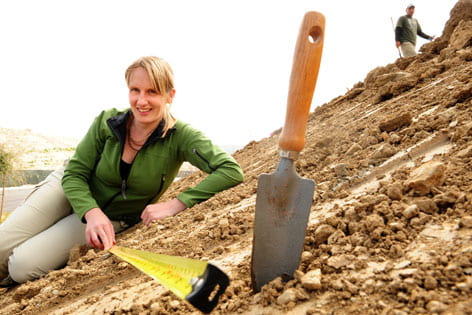Working the Amazon soil
Earth scientist Claudia Czimczik digs in Peru for new dirt on global warming.

Claudia Czimczik is deep in the Amazon rainforest, digging soil from the bottom of a muddy pit. She rolls the dirt between her fingers to feel its texture.
“If you can make it thinner than a pencil, it has a lot of clay. If it breaks apart right away, it’s sandier,” says Czimczik, recalling her 2001 trip to Peru, during which she collected soil for an international study.
Published March 6 in the journal Science, the study found that drought affects the Amazon rainforest more than previously thought, killing trees, which then release carbon, the main contributor to global warming.
Czimczik, a project scientist in UC Irvine’s Department of Earth System Science, played a small but integral part in the study by, well, digging in the dirt.
“For a lot of people, soil is just dirt, and it’s messy when you play with it, but it’s important. It supports the whole forest system, which affects not just local people and weather patterns but the global atmosphere and climate,” Czimczik says. “When we learn how the system works, we appreciate it more.”
Understanding soil composition, she says, can help forest managers make informed decisions on how to use land, such as whether to turn rainforest into farmland.
Originally from Hannover, Germany, Czimczik studied plant ecology, hydrology and soil science in college. “If you want to understand an ecosystem, it’s good if you have basic knowledge about all the components, not just vegetation or soil,” she says. Czimczik became fascinated with tropical soil because its composition is largely unknown.
While a doctoral student at the Max Planck Institute for Biogeochemistry in Jena, Germany, she spent a month in Peru for the Amazon study. She lived in rudimentary field stations, some without running water.
Each day, Czimczik wore several layers of clothing and a hat, despite 90-degree temperatures and 100 percent humidity. “You don’t know what you’re going to brush into when you walk through the forest,” she says.
Alongside botanists surveying trees, Czimczik took soil samples at the surface with a metal coring device. She also dug 2-meter-deep holes that allowed her to sample dirt from different depths. The soil was put in plastic bags, dried and then analyzed for density, texture and nutrient content.
This helped determine how much water trees were getting and how they were reacting to drier conditions, contributing to the ultimate finding that drought kills Amazon trees and perpetuates the global warming cycle.
Peru, Czimczik says, was an adventure. Fieldwork also has taken her deep into the northern forests of Siberia and to Canada and Greenland. “These are not places you would necessarily go on holiday, but fieldwork offers a great chance to explore these wild, remote areas,” she says.
At UCI, Czimczik collects and analyzes gasses, such as carbon dioxide, produced by soil. She says with a laugh: “It’s slightly cleaner work.”